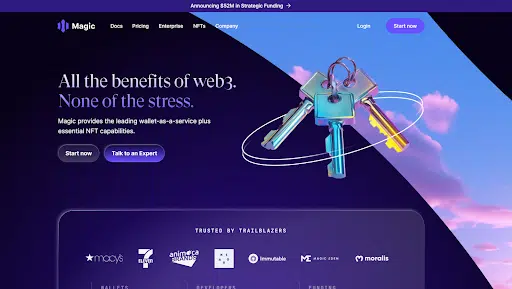An integrated digital wallet is fast becoming a standard element for Web3-based decentralized applications. They make it simpler for developers to onboard new users by abstracting away the complexity of connecting a wallet and buying the crypto that’s needed to explore the services they offer.
To do this, developers are increasingly turning to wallet-as-a-service (WaaS) providers that can handle much of the back-end infrastructure. By using what is essentially a pre-built wallet, developers eliminate the headaches of creating their very own digital wallets, meaning they have more time to focus on the actual functionality of their dApps.
WaaS is often used by developers of blockchain-based video games, where cryptocurrency and non-fungible tokens (NFTs) are an integral part of the game. They’re also employed by other dApps that want to integrate a wallet and provide a simpler experience for end users. By enabling users to spin up an in-app wallet and login with a few clicks, developers can potentially gain many more users who would otherwise be put off by the prospect of having to create and manage their own, third-party digital wallet.
As more developers look to integrate a digital wallet directly into their dApps, a thriving WaaS industry has emerged to cater to this need. In this article, we’ll take a closer look at the top five wallet-as-a-service providers in the crypto industry and see exactly what they have to offer.
1. Magic
Magic might well be the biggest crypto wallet provider you’ve never heard of, offering a white-label platform that other companies can use to create wallets easily for their customers, many of whom might be unfamiliar with Web3 elements such as seed phrases and private keys.
The creators of Magic are focused on providing Web3 tools that can be accessed through the Web2-style interfaces that users are already familiar with. It’s aiming to solve Web3’s onboarding issues, which is one of the main roadblocks to mainstream adoption. In particular, it wants to eliminate the need for users to write down and carefully store a seed phrase for wallet recovery purposes.
On a practical level, every Magic wallet is non-custodial, meaning users control their funds. The company provides developers with a software development kit or SDK that allows them to quickly create wallets tailored to their user’s needs. It can be likened to something such as Twilio or Stripe, which offer white label software for sending text messages within applications.
Once the developer implements Magic’s code within their dApp, users can instantly create a brand new crypto wallet using traditional email, social media or SMS logins. To enable this, Magic employs multi-party computational (MPC) technology, which forms the basis of a patented delegated key management system that enables unrivaled scalability while ensuring users retain full control of their digital assets. It’s coupled with enterprise-grade features such as CCPA, GDPR, SOC2 Type 2, HIPAA and ISO compliance, and supports simple onboarding with traditional authentication tools, fiat onramps, NFT minting and NFT checkout capabilities.
Magic’s wallets can therefore be accessed via any user device, including PCs, smartphones and tablets, and this incredible versatility is what has enabled its platform to generate over 20 million unique wallets in more than 130,000 applications.
2. Privy

Privy is one of the most popular WaaS tools, powering apps such as the SocialFi platform Friend.Tech, the sports card game Courtyard and the dining service Blackbird. Its aim is to combine the privacy benefits of Web3 with the simplicity of traditional Web2 interfaces to let everyone explore the world of crypto for the first time.
With Privy, traditional companies can offer blockchain-style services to their customers. In the case of Blackbird, it uses Privy’s wallet infrastructure within a broader service that restaurants can use to communicate with diners and offer them rewards and other perks. It’s a kind of digital loyalty platform, if you like, that uses crypto to provide Web3 capabilities to users, such as the ability to control access to their data, in familiar application interfaces.
Some might not regard Privy’s wallets as true digital wallets. In the case of Blackbird, the FLY tokens awarded to users are managed via an internal system that is, effectively, a kind of walled garden that’s fenced off from the wider crypto ecosystem. This may alarm true crypto natives, but for many consumers it helps to protect them from the negative aspects of decentralized applications, which are havens for scams and fraud.
Privy argues that it is providing an intermediate step between walled gardens and the truly open nature of crypto, with users able to explore many of the benefits of Web3 in a more secure environment. Its focus on creating easy-to-use applications is certainly paying off, with over 500,000 monthly users who are circulating hundreds of millions of dollars in value across its wallets.
3. ThirdWeb
As a provider of blockchain-based infrastructure and services for developers, ThirdWeb has emerged as one of the industry’s leading WaaS providers. Its Embedded Wallets tools allow users to quickly and easily create their very own digital wallet. They can then be onboarded using a regular email account, with one-click logins, flexible authorization controls and secure account recovery.
ThirdWeb’s Embedded Wallets supports email or social logins as well as any third-party Open ID authentication service. Once the user authenticates themself within the app, they are immediately provisioned with a digital wallet that can be used for on-chain actions such as sending tokens or minting NFTs.
Embedded Wallets support all EVM-based blockchains and support gasless transactions without any single point of failure. The private keys that control each user’s wallet cannot be recreated by ThirdWeb or any developer without the user’s authorization. In addition, ThirdWeb wallets can be connected to other Web3 dApps besides the original application it was integrated with, enabling users to explore other decentralized services once they’re onboard.

4. Dynamic
The goal of Dynamic is to provide consumers with a simple way to spin up a flexible, non-custodial wallet that’s embedded directly into a traditional app. In this way it abstracts away the complexity of crypto for consumers to onboard them into Web3 within seconds through a familiar user interface.
One of the best things about Dynamic’s offering is its flexibility, with developers able to choose from various key management options. Dynamic explains that embedded wallets are not a one-size-fits-all solution, adaptable to specific use cases. The idea is that developers can strike the right balance between the simplified user experience, recoverability, censorship resistance and speed. As such, they have a choice of different infrastructure options.
Like its rivals, Dynamic offers a simplified login experience. It uses PassKeys and secure enclaves to enable login via FaceID and TouchID, for instance, or otherwise users can go the traditional route by providing their email address and a password. In addition, Dynamic also integrates with other WaaS providers, so developers can integrate with various third-party wallets while using its wider blockchain infrastructure. No matter what key management option the developer chooses, all Dynamic wallets support end-user key export and simplified recovery flows.
Dynamic’s embedded wallets also support other features, including account abstraction, fiat onramps that allow users to purchase crypto using traditional payment methods, and the ability to connect with other crypto wallets. Finally, users can also extract their private keys if they feel confident enough to take the step up and create their very own, third-party wallet.

5. Web3Auth
Described as a pluggable wallet infrastructure service for crypto wallets and decentralized applications, Web3Auth is designed to onboard new users into the world of Web3 in under a minute.
By integrating a Web3Auth wallet into their dApps, developers can significantly streamline the onboarding process, ensuring a straightforward experience for users who are entirely unfamiliar with crypto. Its wallets are non-custodial, employing a key management system that allows end users to retain full control over their digital assets.
Web3Auth provides some of the most versatile signup and login options around, with users able to do so using their Google, Twitter and GitHub accounts, as well as traditional email. They can also opt for passwordless registration, where a sign-in link is sent directly to their inbox, negating the need to enter a password each time.
Under the hood, Web3Auth utilizes MPC technology to split the wallet’s private seed phrase between the user and the dApp, preventing anyone but the end user from accessing the wallet. Last but not least, users can choose their favored wallet recovery method, including social media accounts, email-based recovery, trusted devices and more, enabling any wallet to be restored without fear of losing access.






















